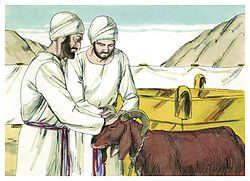
This post is part of a brief series which gives a brief overview of the images used to describe salvation.
In this post we consider the image of the Sacrificial System. Sacrifices involved the manipulation of an animal (bull, goat), vegetable (grain) or liquid (water) as part of religious devotion. This can include ritual slaughter, division, reconfiguration, cooking, consuming, and/or complete burning.
“The Old Testament sacrificial system displays a sequence of sacrifice and offerings suggestive of a complicated and nuanced movement from separation/alienation to inclusion/fellowship.
- The first sacrificial act affected the removal of impurity that infected the sanctuary and altar. This included “pollution arising from the effects of sin and other forms of impurity” (Miller, Religion, 124).
- Once this purification of sacred space and representative humanity had been accomplished, burnt offerings were made to continue the “expiatory function in part but also serving to evoke the deity and prepare for the full communal participation of the worshippers” (Miller, Religion, 124).
- Finally, voluntary gifts of individuals, calendrical offerings, and peace offerings were offered. “The ritual approach was therefore: expiation, consecration, fellowship” (Rainey, “Order,” 498).
 It was not the case that all elements were included in every sacrifice or should be presumed to be included in the silence of the text. Instead, each act of sacrifice in the Old Testament should be taken on its own terms and interpreted as a singular event within a larger complex.
It was not the case that all elements were included in every sacrifice or should be presumed to be included in the silence of the text. Instead, each act of sacrifice in the Old Testament should be taken on its own terms and interpreted as a singular event within a larger complex.
Sacrifice was practiced throughout Israel’s history and thought to be essential for mediating the divine-human relationship.” (Starbuck, S.R.A., 2016. Sacrifice in the Old Testament J. D. Barry et al., eds. The Lexham Bible Dictionary.)
The life blood and death of a sacrifice atones for sins, cleanses and makes a sinner, righteous. Jesus death on the cross justifies sinners. Rom 5.8-10 (‘blood’, death’); 5.19 (one mans obedience = death); Gal 2.21 (‘Christ died’) and Lk 18.13-14 (‘temple’, sacrifice) use this imagery.
6 For while we were still weak, at the right time Christ died for the ungodly. 7 For one will scarcely die for a righteous person—though perhaps for a good person one would dare even to die— 8 but God shows his love for us in that while we were still sinners, Christ died for us. 9 Since, therefore, we have now been justified by his blood, much more shall we be saved by him from the wrath of God. (Rom 5:6–9)
Copyright © Joshua Washington and thescripturesays, 2016. All Rights Reserved.




